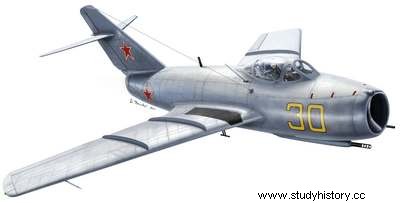
The famous American engineer Clarence L "Kelly" Johnson, creator of the P-38 Lightning and the F-80 Shooting Star, traveled to Korea to talk to the pilots about their combats and their aircraft. He found them dismantling everything that was not absolutely essential for flight and combat. He saw Lt. Col. "Gabby" Gabreski - 28 wins in 40-45 and six and a half in Korea (a "half win" is a win shared between two pilots); Gabreski did not bother with any nuances. Of the APG-30 sight, he told Johnson, "I'd trade it for a piece of gum on my windshield!" ". Johnson returned to California, pondering what had become gum-sight.
This attitude disappeared with the new reactors. Their power removed the effect of the weight of the equipment. By then, the Korean War was over. For at least ten years, American equipment would no longer face Soviet equipment.
The shock caused by the appearance of the MiG15s had almost as much impact as the presence of the Zero-Sen in the Pacific, after Pearl Harbor. But this shock was less justified, and rather the result of a psychological reaction. As for the American pilots, despite their constant superiority, they remained unanimous in their desire to lighten their aircraft - some even considered eliminating the ejection seat!
The search for simplicity hardly reached the B-29 pilots. Superfortresses were repeatedly hitched by MiG-15s; they did very well and a few MiGs were shot down. From the start of operations, it was obvious that bridges and lines of communication were priority objectives. To neutralize the enemy, it was necessary to block its supply. We discovered — or we rediscovered — the difficulty of destroying a bridge. Not only were these very small targets, and to be hit head-on, but in addition an extremely dense anti-aircraft defense made evolutions at less than 1500 m very dangerous.
